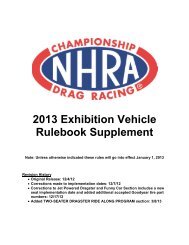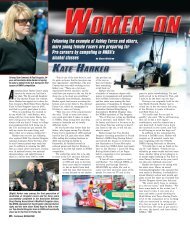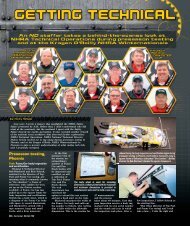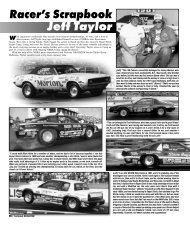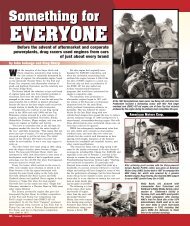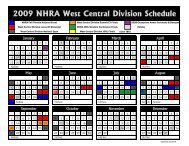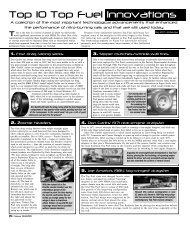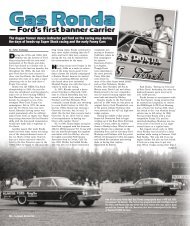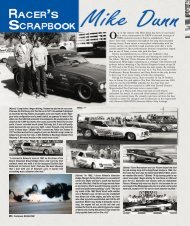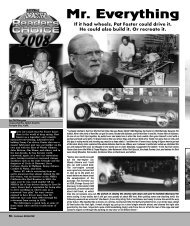1970— Pro Stock debut 1972 — Weight breaks and ... - NHRA.com
1970— Pro Stock debut 1972 — Weight breaks and ... - NHRA.com
1970— Pro Stock debut 1972 — Weight breaks and ... - NHRA.com
Create successful ePaper yourself
Turn your PDF publications into a flip-book with our unique Google optimized e-Paper software.
S<br />
ince the Winternationals became the <strong>NHRA</strong><br />
season opener in 1961, the event traditionally<br />
has been the showcase for impressive<br />
1970 <strong>—</strong> <strong>Pro</strong> <strong>Stock</strong> <strong>debut</strong><br />
The first <strong>NHRA</strong> national event to host a <strong>Pro</strong> <strong>Stock</strong><br />
<strong>com</strong>petition was the 1970 Winternationals, which st<strong>and</strong>s<br />
out for how radically different the original breed of factory<br />
hot rods was from the technologically advanced marvels<br />
that <strong>com</strong>pete today. The first <strong>Pro</strong> <strong>Stock</strong>ers were made from<br />
stock-framed, factory-produced vehicles (no tube chassis)<br />
<strong>and</strong> ran at a weight factor of 7.0 pounds per cubic inch<br />
<strong>com</strong>pared with today’s factor of 4.7 pounds per cubic inch,<br />
including driver. That put the 427 Chevy <strong>and</strong> Ford entries<br />
<strong>and</strong> the 426-cid Mopar vehicles at just under 3,000 pounds.<br />
Current <strong>Pro</strong> <strong>Stock</strong>ers have a 500-cid engine <strong>and</strong> weigh<br />
2,350 pounds, including driver.<br />
Despite such h<strong>and</strong>icaps, the first <strong>Pro</strong> <strong>Stock</strong>ers<br />
produced nine-second clockings, led by Bill Jenkins’ low<br />
e.t. of the meet 9.98. By the end of the inaugural season,<br />
Don Nicholson’s Ford Maverick had lowered the national<br />
record to 9.81.<br />
Not only did Jenkins’ small-block Vega win the first <strong>NHRA</strong> national event<br />
in which weight <strong>breaks</strong> were implemented, but it was also the first <strong>Pro</strong><br />
<strong>Stock</strong>er to use tube-frame chassis <strong>com</strong>ponents, installed from the firewall<br />
back. The front frame <strong>and</strong> front suspension, though braced with extra tubing,<br />
were still essentially stock. Jenkins did not introduce the first<br />
McPherson strut front suspension until the 1974 Gatornationals.<br />
1973 <strong>—</strong> Lenco clutchless four-speed transmission<br />
The 1973 Winternationals was run over three weekends because of multiple rainouts, <strong>and</strong> by the time the race<br />
was <strong>com</strong>pleted, the l<strong>and</strong>scape of <strong>Pro</strong> <strong>Stock</strong> had changed significantly with the introduction of the Lenco clutchless<br />
four-speed transmission. Prior to this race, manually shifted units had been used almost exclusively. Fans were<br />
thrilled to witness the skills of true four-speed wizards such as Ronnie Sox <strong>and</strong> Nicholson, but the high rate of drivetrain<br />
breakage was elevating maintenance costs at an alarming rate.<br />
The Lenco transmission, with its planetary gears, permitted clutchless shifting that was not only easier on the<br />
driveshaft <strong>and</strong> rear-end assembly but made every driver in the class just as consistent as Sox.<br />
During the first weekend of the Winternationals, Lenco-equipped cars took three of the top four positions, led by<br />
Nicholson’s 9.41 with his Ford Pinto; Melvin Yow, in Stepp’s Dodge, <strong>and</strong> Jack Roush’s Pinto took the No. 3 <strong>and</strong> 4<br />
spots, respectively. Only No. 2 qualifier Jenkins, who ran a 9.42 with his ’72 Vega, was among the elite runners<br />
with a manually shifted four-speed.<br />
More teams jumped on the Lenco b<strong>and</strong>wagon during the second weekend of qualifying; Don Carlton lead the way<br />
in Ted Spehar’s Motown Missile Dodge with a sensational 9.22, at the time the quickest run ever recorded by an<br />
<strong>NHRA</strong>-legal <strong>Pro</strong> <strong>Stock</strong>er.<br />
By the time eliminations were finally <strong>com</strong>pleted, virtually every <strong>Pro</strong> <strong>Stock</strong> team had switched to a planetary-type<br />
transmission or was making plans to do so.<br />
64 ✦ National DRAGSTER<br />
technological advancements <strong>and</strong> memorable pivotal<br />
happenings, occurrences that set the tone<br />
for the rest of the season. The trend is espe-<br />
cially notable in the <strong>Pro</strong> <strong>Stock</strong> class, which got<br />
its start at the fabled Pomona Raceway event 35<br />
years ago.<br />
The winner of <strong>NHRA</strong>’s first <strong>Pro</strong> <strong>Stock</strong> national event title was Bill “Grumpy” Jenkins, at the 1970 Winternationals. His<br />
Camaro <strong>com</strong>pares tamely to today’s nine-second Super Gas cars <strong>and</strong>, except for its fiberglass body <strong>com</strong>ponents <strong>and</strong><br />
hood scoop, it actually <strong>com</strong>pares more closely to a current <strong>Stock</strong> entry. The car’s stock chassis was modified only<br />
by framerail connectors, stock A-frame front suspension, <strong>and</strong> stock-type leaf springs equipped with traction bars.<br />
<strong>1972</strong> <strong>—</strong> <strong>Weight</strong> <strong>breaks</strong> <strong>and</strong> tube chassis<br />
After the first two seasons of <strong>Pro</strong> <strong>Stock</strong> <strong>com</strong>petition in 1970 <strong>and</strong> 1971, there was no doubt that<br />
the factory hot rod category was a big hit with the fans. But <strong>NHRA</strong> officials were concerned that<br />
the overwhelming success of the Dodge <strong>and</strong> Plymouth entries, which had won 12 of the 15 races<br />
held during those two years, could hurt the class.<br />
Said then-<strong>NHRA</strong> Competition Director Steve Gibbs, “At the end of 1971, there was no doubt that<br />
Chrysler had achieved total domination of <strong>Pro</strong> <strong>Stock</strong>, <strong>and</strong> the class was bound to suffer. We decided<br />
to implement weight <strong>breaks</strong> to encourage some other makes to get back into the program.”<br />
<strong>NHRA</strong> accordingly switched from the original 7.0 factor for all types of cars to 6.75 for<br />
small-block entries <strong>and</strong> 7.25 for cars with big-blocks.<br />
Only one small-block entry showed up at the <strong>1972</strong> season opener in Pomona: Jenkins’ 331-cid<br />
Chevrolet Vega. Said Jenkins, “I was going to build the Vega whether <strong>NHRA</strong> went with a weightbreak<br />
format or not. I could’ve used it for match races.”<br />
Tuning problems held Jenkins to a qualifying best of 9.90, which put him in the 17th position<br />
of the 32-car field <strong>and</strong> forced him to race Stu McDade, driver of Billy Stepp’s Dodge Challenger<br />
that had qualified No. 1 with a 9.59. But Jenkins made some pivotal suspension changes prior to<br />
the first round <strong>and</strong> managed to quicken his pace to a 9.63 to defeat McDade’s 9.75. Jenkins went<br />
on to defeat four more Hemis to score a crowdpleasing victory, the first of six wins in eight races<br />
that earned him the <strong>1972</strong> <strong>NHRA</strong> <strong>Pro</strong> <strong>Stock</strong> championship.<br />
Ford later got into the act with small-block Pintos campaigned by the likes of Bob Glidden,<br />
Gapp & Roush, <strong>and</strong> Nicholson, who won the <strong>NHRA</strong> <strong>Pro</strong> <strong>Stock</strong> title in 1973.<br />
to page 66<br />
Though Don Nicholson was known as one of the<br />
nation’s more skilled drivers with a manually shifted<br />
four-speed transmission, he had no trouble making<br />
the transition to the Lenco clutchless four-speed at the<br />
1973 Winternationals, where he won the event <strong>and</strong> set<br />
new national records of 9.38 seconds <strong>and</strong> 148.76 mph.
from page 64<br />
1979 <strong>—</strong> Glidden’s Plymouth Arrow<br />
Bob Glidden had enjoyed the best season of his career thus far <strong>—</strong> seven wins<br />
in nine national events with his Ford Fairmont <strong>—</strong> in 1978, so it was shocking that<br />
he came to the 1979 Winternationals with a Plymouth Arrow powered by a smallblock<br />
Mopar engine. Most trackside observers predicted it would take Glidden at<br />
least six months to sort out the new <strong>com</strong>bination, but Glidden secretly had been<br />
working on the project during the last half of 1978 <strong>and</strong> was in midseason form in<br />
Pomona, where he not only won the event but tied the national record with a low<br />
e.t. of the meet 8.49 <strong>and</strong> set top speed at 159.57 mph.<br />
Said Glidden, “We’d had a lot of success on the track with our Ford<br />
program in 1978, but I wasn’t getting any financial support from [Ford].<br />
Plymouth approached me during the middle of the year <strong>and</strong> offered some<br />
money if I would switch to one of their cars.”<br />
Glidden tested the new Arrow one week prior to the Winternationals. “It<br />
was the first time the car went down the track,” said Glidden, “but we knew<br />
right then that the car was going to be pretty quick <strong>and</strong> fast.”<br />
After h<strong>and</strong>ily winning the Winternationals, Glidden went on to win seven of<br />
the year’s nine events for the second campaign in a row, losing his only two races<br />
on red-light starts in the final of each event. “To us,” said Glidden, “the Arrow<br />
was even more successful than my undefeated Fairmont, especially when you<br />
consider that we had to start from scratch with an entirely new <strong>com</strong>bination.”<br />
Glidden would have continued his program with Plymouth, but Chrysler<br />
suffered a financial crisis in 1979 <strong>and</strong> claimed bankruptcy. “Contracts like<br />
mine were the first to go,” said Glidden. “Fortunately, we were able to go<br />
back to Ford, <strong>and</strong> this time they came up with some financial support.”<br />
1983<strong>—</strong> Aerodynamic <strong>Pro</strong> <strong>Stock</strong>ers<br />
With the advent of the more powerful 500-cid engines in 1982 that<br />
quickly pushed <strong>Pro</strong> <strong>Stock</strong> speeds from 165 to 180 mph, aerodynamic<br />
factors became considerably more significant. Consequently, General<br />
Motors had Reher-Morrison bring its Don Ness-built Camaro to the<br />
corporation’s wind-tunnel facility in Detroit for three days of extensive<br />
testing <strong>and</strong> evaluation. Said David Reher, “We had a big audience for<br />
those tests. All eight of the GM aerodynamic engineers were present,<br />
including Gary Acker, who later went to the Hendricks NASCAR team<br />
<strong>and</strong> now has his own wind-tunnel operation in Mooresville, N.C.<br />
“A lot of those ideas were implemented onto our car before the 1983<br />
Winternationals. Other things evolved after that, including the flatter<br />
spoiler that you still see these days, <strong>and</strong> extending the back of the hood<br />
scoop all the way to the windshield to eliminate the air turbulence we had<br />
previously experienced. Gary established just about every area of development<br />
that we still work on today, <strong>and</strong> Don was an excellent on-the-spot<br />
fabricator for the desired modifications. We are still looking for aerodynamic<br />
gains, but it’s like our current engine development in that we’re<br />
approaching the point of diminishing returns, <strong>and</strong> significant gains are<br />
harder to <strong>com</strong>e by.”<br />
to page 69<br />
66 ✦ National DRAGSTER<br />
Glidden qualified his new Plymouth Arrow No. 1 with an 8.56 he recorded in the first session.<br />
He then turned times of 8.59, 8.50, <strong>and</strong> 8.55 during eliminations to reach the final, where he<br />
defeated Joe Satmary’s Camaro, 8.49 to 8.71.<br />
1982 <strong>—</strong> The 500-cid mountain motor<br />
When weight <strong>breaks</strong> were first introduced to <strong>Pro</strong> <strong>Stock</strong> for the <strong>1972</strong> season, there were just two:<br />
for cars with either small- or big-block engines. A third was later added for canted-valve wedge<br />
engines, followed by two more for cars either over or under a wheelbase dimension of 105 inches.<br />
By the 1981 season, weight <strong>breaks</strong> had evolved into one for every type of engine raced in <strong>Pro</strong><br />
<strong>Stock</strong>, 11 at the time, <strong>and</strong> the total number was doubled to 22 with the wheelbase factors. Racers<br />
<strong>and</strong> sanctioning-body officials alike had grown weary of the disputes over weight <strong>breaks</strong>, which<br />
were also changed at various points of the season, so the decision to return to a heads-up format<br />
in 1982 was wel<strong>com</strong>ed by all parties<br />
involved.<br />
The weight <strong>breaks</strong> were tossed<br />
out in spectacular fashion with the<br />
introduction of the 500-cid<br />
mountain motors, which would<br />
produce a quantum leap in horsepower<br />
<strong>and</strong> torque over the 330- to<br />
350-cid engines most <strong>com</strong>monly<br />
used through the end of 1981. With<br />
Lee Shepherd, near lane, earned the distinction of producing <strong>NHRA</strong>’s<br />
first seven-second <strong>Pro</strong> <strong>Stock</strong> run with a 7.86 during Thursday’s opening<br />
qualifying session. Clutch problems slowed Shepherd to an 8.02<br />
in the final, <strong>and</strong> Frank Iaconio won the event with a 7.83. Iaconio also<br />
came away with a national record of 7.82, shattering the old weight- a new minimum weight of 2,350<br />
break st<strong>and</strong>ard of 8.23. pounds, including the driver, this Bob Glidden, who was preparing this Ford EXP to be raced with a<br />
new package promised great gains small-block engine on the premise that the weight-break format<br />
in performance, <strong>and</strong> the <strong>debut</strong> of the new format at the 1982 Winternationals more than lived up to its would be continued in 1982, was surprised by the announcement late<br />
advance billing with 7.8-second elapsed times <strong>and</strong> 174-mph speeds.<br />
in 1981 that the 500-cid rules would be implemented. He showed up<br />
Perhaps the best measuring stick regarding this rule change is that it has remained virtually<br />
at the Winternationals with his car hastily converted to accept the<br />
untouched for 23 years. Racers have been able to focus on this format, resulting in the 6.6-second larger powerplant <strong>and</strong> not only managed to qualify third with a 7.89,<br />
elapsed times <strong>and</strong> nearly 208-mph speeds that are truly amazing for a naturally aspirated engine<br />
but he also reached the semifinals in eliminations.<br />
running on automotive-type gasoline.<br />
This Reher-Morrison Camaro was subjected to an extensive three-day wind-tunnel test, the first<br />
of its kind for a <strong>Pro</strong> <strong>Stock</strong> vehicle, at the General Motors facility in Detroit. This car showed up<br />
at the 1983 Winternationals with a number of aerodynamic improvements that resulted from<br />
that session, including lowered rocker panels, modified wheelwell openings, flush-mounted<br />
windshield <strong>and</strong> windows, <strong>and</strong> other significant developments.
The Don Ness-built cars of<br />
Butch Leal (right) <strong>and</strong><br />
Iaconio showed up at the<br />
1985 Winternationals with<br />
what is to believed to be<br />
the first examples of the<br />
driver-encapsulated (or<br />
Funny Car-style) roll cage.<br />
It was designed to retain<br />
the driver in the cockpit<br />
seat <strong>and</strong> keep him or her<br />
within the protective area<br />
of the basic roll cage in<br />
cases of turnovers during<br />
high-speed incidents.<br />
Warren Johnson<br />
implemented a similar<br />
configuration in his<br />
Oldsmobile Calais that year.<br />
The modification has been<br />
st<strong>and</strong>ard equipment on all<br />
<strong>Pro</strong> <strong>Stock</strong> vehicles for<br />
many years.<br />
2001 <strong>—</strong> St<strong>and</strong>ardized body styles<br />
With so many <strong>Pro</strong> <strong>Stock</strong> races being decided by mere<br />
thous<strong>and</strong>ths of a second, such considerations as the length of<br />
the front overhang of the body, which trips the win light at the<br />
finish line, became a critical factor that favored cars with longer<br />
dimensions in that area. In an effort to level the playing field,<br />
<strong>NHRA</strong> began the practice of st<strong>and</strong>ardizing body specifications.<br />
Said longtime <strong>Pro</strong> <strong>Stock</strong> chassis builder Jerry Haas,<br />
“The Chevrolet Cavalier <strong>and</strong> Pontiac Gr<strong>and</strong> Am were introduced<br />
[in 2001] to replace the Camaro <strong>and</strong> Firebird, which<br />
made it a good time to implement rule changes. The<br />
Oldsmobile Cutlass body, which had been used for several<br />
years, had a 105-inch wheelbase, <strong>and</strong> that was selected as<br />
the st<strong>and</strong>ard specification. <strong>NHRA</strong> also decided to allow a<br />
45-inch measurement from the spindle to the nose of the<br />
car to st<strong>and</strong>ardize the front ends. We were able to implement<br />
these changes while still retaining the basic shape of<br />
each body design in order to maintain proper br<strong>and</strong> identity.<br />
I think that it is one of the selling points of <strong>Pro</strong> <strong>Stock</strong><br />
in that you don’t have to read a car name on the bumper in<br />
order to tell what br<strong>and</strong> or model it is.”<br />
2004 <strong>—</strong> Beadlock tires<br />
According to Warren Johnson, “The implementation of the beadlock<br />
wheel/tire <strong>com</strong>bination for <strong>Pro</strong> <strong>Stock</strong>ers in 2004 probably did as much to<br />
provide additional safety for the class as did the Funny Car-style roll cages that<br />
were introduced in the mid-1980s. The former method of attaching the tire <strong>and</strong><br />
wheel together with a bunch of sheet-metal screws had be<strong>com</strong>e archaic <strong>and</strong><br />
highly unsafe. In a tubeless configuration, all you need is to break the seal just<br />
a little bit <strong>and</strong> you have a flat tire, which can spell disaster when you’re at<br />
speeds at well over 205 mph at the finish line.”<br />
Admittedly, there was a significant amount of opposition to the new regulations,<br />
which took effect at the 2004 Winternationals. Among the issues cited<br />
was the extra reciprocating weight as a performance-inhibiting factor, increased<br />
costs to beef up the rear-axle housing assembly,<br />
<strong>and</strong> the testing <strong>and</strong> development procedures to<br />
produce stronger ring-<strong>and</strong>-pinion gears with<br />
optimum ratios.<br />
Greg Anderson dissipated any fears of<br />
performance setbacks when he began the<br />
“beadlock era” by breaking his Pomona Raceway<br />
track records of 6.733, 205.51 mph with new st<strong>and</strong>ards<br />
of 6.706, 206.13.<br />
Johnson added, “In the 18 months [prior] to this<br />
decision, we had seen a number of drivers get<br />
upside down when their cars got out of the groove,<br />
<strong>and</strong> all of those incidents could’ve been averted<br />
with the beadlock tire. This turned out to be a winwin<br />
situation for all concerned.” ND<br />
from page 66<br />
1985 <strong>—</strong> Funny Car-style roll cages<br />
Higher speeds required not only improved aerodynamics but<br />
extra driver protection for a class that originally began<br />
running at speeds of 140 mph or slower. Said chassis builder<br />
Ness, “It became apparent to us that more needed to be done<br />
to contain the driver within the parameters of the roll cage in<br />
case [a car lost control] at high speeds, so we came up with an<br />
additional framework that encapsulated the driver. The first<br />
two such cars I built were a Pontiac Firebird for Butch Leal on<br />
the Rod Shop team <strong>and</strong> Frank Iaconio’s Budweiser-sponsored<br />
Ford Thunderbird. I think Warren Johnson came up with a<br />
similar design for his Oldsmobile Calais that year.”<br />
“The G force that a driver’s body is subjected to when a car<br />
flips at high speed is beyond imagination,” said Ness. “We<br />
needed that extra reinforcement located close to his body to<br />
keep him safely harnessed to the driver’s seat <strong>and</strong> retained<br />
within the protective framework of the already st<strong>and</strong>ardized<br />
roll cage. I think this design has proven its value numerous<br />
times over the years when we’ve seen drivers walk away from<br />
what looked to be some pretty spectacular incidents. <strong>NHRA</strong><br />
<strong>and</strong> the SFI Foundation were instrumental in helping us<br />
develop the specifications to make this modification a requirement<br />
within the <strong>NHRA</strong> rules.”<br />
With the introduction of the new Chevrolet Cavalier <strong>and</strong> Pontiac Gr<strong>and</strong> Am body styles in 2001, such as<br />
those campaigned respectively by Kurt Johnson, near lane, <strong>and</strong> Bruce Allen, <strong>NHRA</strong> decided to<br />
st<strong>and</strong>ardize the wheelbase dimension at 105 inches <strong>and</strong> the spindle-to-nose front overhang at 45 inches.<br />
The latter specification was significant because it eliminated the inherent advantage of vehicles with a<br />
longer nose tripping the win light at the finish line.<br />
(Above) Through the 2003 season, <strong>Pro</strong> <strong>Stock</strong> cars used<br />
sheet-metal screws to attach the wheel <strong>and</strong> tire together, a<br />
procedure that dated back to the 10-second, 128-mph<br />
A/Factory Experimental cars campaigned in 1964. (Left)<br />
Beginning with the 2004 Winternationals, <strong>Pro</strong> <strong>Stock</strong>ers<br />
were required to use 16-inch beadlock wheels, which<br />
consisted of an outer rim connected to the wheel by a large<br />
number of fasteners to keep the tire firmly in place. Not only<br />
did this new rule help provide better sealing capabilities for<br />
the tubeless rear slicks, but it improved the stability of <strong>Pro</strong><br />
<strong>Stock</strong> vehicles, resulting in fewer aborted runs.<br />
February 11, 2005 ✦ 69



